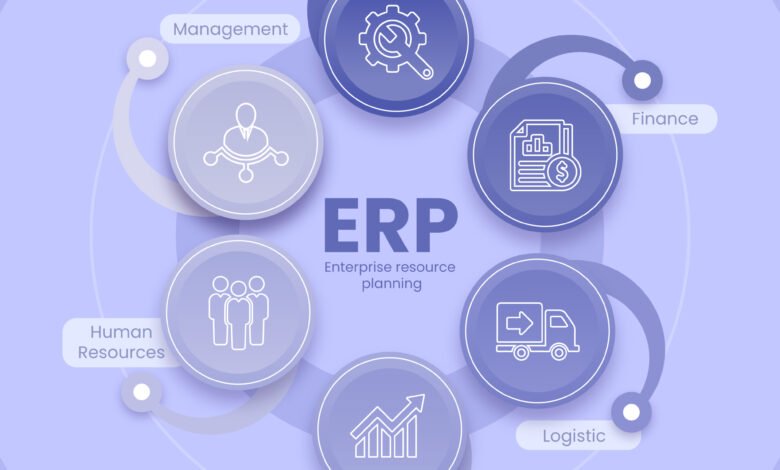
I. Introduction
In today’s fast-paced business environment, organizations are constantly striving to enhance efficiency and productivity to stay ahead of the competition. One of the most effective ways to achieve this is through the integration of Enterprise Resource Planning (ERP) and Human Resource Management System (HRMS) software. This blog explores the synergistic relationship between ERP and HRMS software and how their integration can revolutionize organizational operations.
II. Understanding ERP Software: A Holistic Approach to Operations
ERP software serves as the backbone of organizational operations, providing a centralized platform to manage various business processes seamlessly. From inventory management and procurement to financial reporting and customer relationship management, ERP software streamlines operations and improves visibility across the organization. By automating repetitive tasks and providing real-time insights, ERP software enables organizations to make informed decisions and respond swiftly to changing market dynamics.
III. Exploring HRMS Software: Empowering Human Capital
HRMS software focuses on managing the human resources aspect of an organization, covering recruitment, employee onboarding, performance management, and payroll processing. By automating HR processes and centralizing employee data, HRMS software simplifies administrative tasks and enhances workforce management. Additionally, HRMS software facilitates talent development initiatives, such as training programs and career planning, to nurture employee growth and engagement.
IV. The Power of Integration: Seamlessly Connecting Operations and People
When ERP and HRMS software are integrated, they create a unified platform that connects operational and human resource functions. This integration allows for seamless data flow between departments, enabling better collaboration and decision-making. For example, employee data from the HRMS can be utilized in ERP modules for resource planning and allocation, leading to more accurate forecasts and resource optimization. By breaking down silos and fostering cross-functional communication, integrated ERP and HRMS software promote organizational alignment and efficiency.
V. Streamlining Processes: Enhancing Operational Efficiency
One of the key benefits of ERP and HRMS integration is the streamlining of processes across the organization. By automating workflows and eliminating manual interventions, integrated systems reduce the risk of errors and improve operational efficiency. For instance, when an employee’s information is updated in the HRMS, it automatically reflects in the ERP system, ensuring consistency and accuracy in payroll processing and benefits administration. This streamlining of processes not only saves time and resources but also improves data integrity and compliance.
VI. Empowering Decision-Making: Leveraging Data Insights
Integrated ERP and HRMS software provide organizations with valuable data insights that can drive strategic decision-making. By combining financial data from ERP modules with HR metrics from the HRMS, organizations gain a comprehensive view of their business performance and workforce dynamics. This data-driven approach enables leaders to identify trends, anticipate challenges, and capitalize on opportunities for growth. For example, by analyzing employee performance data alongside sales figures, organizations can identify high-performing teams and align incentives to drive sales growth.
VII. Fostering Employee Engagement: Cultivating a Positive Workplace Culture
Employee engagement is crucial for organizational success, and integrated ERP and HRMS software play a vital role in fostering a positive workplace culture. Through self-service portals and employee engagement tools, employees can access relevant information, such as performance feedback and career development opportunities. Moreover, integrated systems enable HR teams to design personalized employee experiences, leading to higher levels of job satisfaction and retention. By investing in employee engagement initiatives, organizations can create a motivated and productive workforce that drives business success.
VIII. Ensuring Compliance: Meeting Regulatory Requirements
Compliance with labor laws and industry regulations is essential for organizations to avoid legal repercussions and reputational damage. Integrated ERP and HRMS software help organizations stay compliant by automating compliance-related processes and maintaining accurate records. For example, HRMS modules can track employee certifications and training requirements, ensuring that organizations meet regulatory standards. Additionally, ERP modules can generate reports for audits and regulatory filings, streamlining compliance management processes. By staying proactive about compliance, organizations can mitigate risks and build trust with stakeholders.
IX. Scaling for Growth: Adapting to Changing Business Needs
As organizations evolve and grow, they need scalable solutions that can accommodate their changing needs. Integrated ERP and HRMS software provide the flexibility and scalability that organizations need to adapt to growth. Whether expanding into new markets, adding new product lines, or increasing the workforce, integrated systems can scale seamlessly to meet evolving requirements. This scalability ensures that organizations can continue to operate efficiently and effectively, regardless of their size or industry.
X. Embracing Innovation: Driving Continuous Improvement
Innovation is the key to staying ahead in today’s competitive business landscape, and integrated ERP and HRMS software can help organizations drive continuous improvement. By leveraging emerging technologies such as artificial intelligence and machine learning, organizations can automate repetitive tasks, optimize processes, and unlock new insights. For example, AI-powered analytics can help organizations identify trends and patterns in employee performance data, enabling them to make data-driven decisions about talent management and workforce planning. By embracing innovation, organizations can stay agile and resilient in the face of change.
XI. Enhancing Customer Experience: Delivering Value
Integrated ERP and HRMS software not only improve internal operations but also enhance the overall customer experience. By streamlining processes and improving efficiency, organizations can deliver products and services more effectively, leading to higher customer satisfaction and loyalty. For example, integrated systems can provide real-time updates on order status and inventory availability, enabling organizations to respond quickly to customer inquiries and requests. By focusing on delivering value to customers, organizations can differentiate themselves in the market and build long-term relationships with customers.
XII. Conclusion: Embracing the Future of Work
In conclusion, the integration of ERP and HRMS software represents a significant opportunity for organizations to unlock operational efficiency, drive growth, and foster innovation. By seamlessly connecting operations and people, integrated systems enable organizations to streamline processes, empower employees, and make data-driven decisions that propel business success. As organizations continue to adapt to the evolving business landscape, those that embrace ERP and HRMS integration will be well-positioned to thrive in the digital age. By investing in integrated solutions and fostering a culture of continuous improvement, organizations can position themselves for long-term success and create value for all stakeholders.



